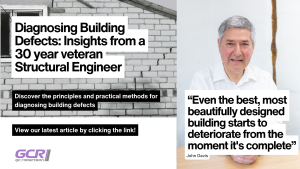
Understanding and diagnosing building defects is crucial for maintaining the structural integrity and safety of buildings. John Davis, of GC Robertson, has extensive experience in this field providing this comprehensive framework for identifying and addressing these issues. This article will guide you through the principles and practical methods for diagnosing building defects, based on John Davis’s 30 years’ experience as a Structural Engineer in East Anglia.
John Davis has dedicated 30 years to diagnosing defects in traditional buildings, primarily in Suffolk and its surrounding counties. The principles discussed here are broadly applicable across various building types and regions, but omits defects like mining subsidence or defects and stonework.
Principles of Diagnosis
Diagnosing structural faults requires meticulous attention to detail and a systematic approach. It involves understanding the building’s history, construction methods, and environmental factors to determine the root cause of defects.
John Davis: “In essence, I’m going to discuss how to determine the causes of structural faults in buildings and give you a sense that this is a real discipline in its own right. It’s varied and fun to practice.”

Building Deterioration
Buildings begin to deteriorate immediately upon completion. Regular maintenance and repairs are essential to prolong a building’s lifespan, as deterioration continues until a building is either demolished or becomes uninhabitable.
John states:
“Even the best, most beautifully designed building starts to deteriorate from the moment it’s complete, and carries on deteriorating until it’s demolished or becomes uninhabitable.”
Causes of Structural Defects
Defects can manifest in various forms, primarily as cracks or distortions. Identifying the underlying cause is crucial before implementing repairs.
Structural Inadequacy
- In-plane Defects: Distorted beams, lintels, rafters, floor joists, and trusses.
- Out-of-plane Defects: Lack of restraint to walls, roof spread, and wall racking.
John Davis: “These can cover structural inadequacy in-plane – for instance, distorted beams, lintels, rafters, floor joists, trusses. Structural inadequacy out-of-plane. Lack of restraint to walls roof spread to walls racking of walls or roof structures.”
Deterioration of Materials
- Rusting of Steel: Corrosion protection measures should comply with BS EN ISO 12944, which covers corrosion protection of steel structures by protective paint systems.
- Timber Decay: Fungal, bacterial, or insect attacks on timber can be significant. BRE Digest 299 provides guidance on identifying and treating timber decay.
- Masonry Damage: Frost or salt damage to masonry, and sulphate attack on concrete or brickwork, require thorough investigation. BRE Digest 251 outlines methods for diagnosing and repairing masonry damage.
Foundation Movement
- Washout: Defects due to washout from leaking drains or water mains are common. Defects can occur quickly (with leaking water mains) or slowly (with leaking drains) depending on the situation.
- Shrinkage/ heave of Clay: The presence of trees and other vegetation can cause clay shrinkage, leading to structural movement. These often occur quickly, usually in the autumn and can recur on an annual basis.
- Made or poor ground: loose material under foundations which can compact under loading is a common cause of subsidence.
John advises:
Knowledge of likely ground conditions and their possible contribution to defects is very useful.

Practical Examples of Defect Causes
- Diagonal Cracks: Often indicate foundation movement, especially in conjunction with diagonal ceiling cracks.
- Vertical Cracks: Typically due to thermal or moisture-related movement, or roof spread.
- Horizontal Cracks: Can signify wall tie corrosion.

Ground Conditions
Knowledge of local ground conditions is vital. Geological maps and surveys can provide insights into soil types and their behaviour. John recommends that British Geological Survey (BGS) maps can be especially useful.
Equipment for Investigation
Proper tools and equipment are essential for thorough investigation. John explains what is in his basic toolkit:
When I visit site I carry a bag that’s got various bits of equipment in it. Pad and paper, some pencils, scale rule tape or a couple of tapes. I lose them a lot, so normally a couple of tapes is good. A disto, bradawl for prodding timber, torch, a hacksaw blade for putting between floor joists, moisture meter chalk and a crack gauge. In the car, there’s more equipment. A collapsible ladder, a hand auger, Mackintosh probe, spade, spirit level, water level and cat scanner.

John provides some advice for structural engineers who are diagnosing building defects:
By far the most important thing to bring with you is your senses. It is a truism that the value of a house depends on three factors, location, location and location. Being able to diagnose building defects depends on observation, observation and observation. You need to keep looking with an open mind, and sometimes get yourself in the right position to see the defects.
Investigating Building Defects
The process begins with a thorough inspection. By comparing results from various inspections and surveys, you can hone in on the root cause. For instance, if diagonal cracking is noted and foundation movement is suspected, a distortion survey can be conducted.
John Davis: All these methods of investigation have their flaws, analogous to the false positives or false negatives of medical screening. For instance a brick course level survey may just show up poor construction, and sometimes you find sand where the geological map shows clay, (and the other way round). Patrick Robson’s insight was that if you undertake several of these tests on a building and the results are consistent you can be far more confident in your diagnosis, and there is always the option of doing more tests. It is a simple but very powerful insight.

Building up Knowledge and Experience
Finally, John explains why it’s important for structural engineers to continue to build up knowledge and experience, and recommends some useful reading material for Structural Engineers coming through the ranks:
When I started investigating defective buildings in the early 1990’s it was very much a learning curve, and I made some, in retrospect, elementary mistakes. Then there was a sudden severe recession and our work on new structural designs dried up almost overnight. If you are young, you will be sure to experience this several times in your career, it’s not very pleasant!
John continues:
Luckily 1990-1991 was a very dry couple of years, and back then loss adjusters used structural engineers to investigate subsidence problems – and there were lots of them. I looked round for guidance on how to investigate defective buildings, BRE reports and digests are very helpful in some cases, but they did not give practical advice on how to diagnose faults. What did help was Patrick Robson’s excellent book, ‘The Structural Appraisal of Traditional Buildings’. In the book he described many typical defects and their causes, but also a methodical method of homing in on the right cause. The methods he uses are really different ways of looking at the building in question.
Contact GC Robertson for Experienced Structural Engineers
Diagnosing building defects requires a combination of different investigative techniques. Through detailed surveys and methodical testing, accurate diagnoses can be made, leading to appropriate repair specifications. The insights gained from these processes are crucial for ensuring structural integrity and safety.
For more information on diagnosing building defects and to consult with our experts, contact GC Robertson today.
Phone: 01394 384887
We thank John Davis for his contribution to this article.
